full article:
Migrant farmworkers
There are an estimated one million migrant farmworkers who live and work in the USA1. Approximately 65 percent of agricultural workers in the USA were born in Mexico2 and the vast majority live in rural settings, below the poverty line, and have limited access to healthcare services3-6. Most migrant farmworkers are male, many have limited formal education, and some speak an indigenous language rather than Spanish as their primary language7,8. The majority of migrant farmworkers are married, and nearly 63 percent of those are accompanied by families or children when living and working elsewhere3. Approximately one half of migrant farmworkers do not have the appropriate documents to legally work in the USA9. Some farmworkers are employed through the H-2A visa program, a guest-worker program that allows individuals to work for an agricultural employer for a determined period of time before having to return to their home country each year9.
Migrant farmworker housing conditions
Migrant farmworkers are a group whose housing quality in the USA is directly linked to employment, sometimes as a part of their compensation10. Some migrant workers rent short-term housing on the private market, but more often they live in group quarters or individual homes or trailers provided and regulated by their employer11. The pattern of housing acquisition varies regionally, with most farmworkers in California finding their own housing and the majority of the workers on the East Coast living in housing provided by employers12-14. Additionally, farmworkers on the West Coast of the USA have recently shown a trend of living in urban areas (defined as both metropolitan and incorporated cities) as compared to East Coast farmworkers living in predominantly rural settings (including unincorporated areas)14.
Migrant farmworker housing is regulated by the Migrant and Seasonal Farmworker Protection Act (MSPA)7. Individual states have jurisdiction over enforcement of housing regulations and in North Carolina, the Department of Labor oversees housing regulations15. Such regulations are necessary because they provide standards for living and sleeping spaces, kitchen and laundry facilities, and general safety and sanitation7. However, certain housing features are not required and are subject to individual choices made by the housing owner, such as having dividers between the toilets or private showers7. Violations of housing regulations are common occurrences in North Carolina7,10. Arcury et al7 found that 4-22 housing violations occurred per camp in North Carolina with the mean close to 11. Having camps with H2-A workers, posting an NC Department of Labor Certificate of Inspection, and conducting camp assessment earlier in the agricultural season were associated with fewer housing violations7.
In general, migrant farmworkers are low paid, lack access to health insurance and health services, and are employed in extremely hazardous conditions, yet they are a key component of the USA agricultural system3. Previous ethnographic research has focused on the agricultural work environment, migration patterns, health experiences, and the relations between growers and workers4,16,17. Understanding the perceptions of housing conditions from the perspective of migrant farmworkers has not been previously described. Therefore, the purpose of this study was to fill this gap by delineating the experiences and perceptions of migrant farmworkers concerning the quality of the housing in which they live, as well as understanding potential impacts of housing on health and safety.
The data presented here were collected as the qualitative component of a larger community-based participatory research study to document housing quality and health among North Carolina farmworkers7,18-21 . Collaborating organizations included the North Carolina Farmworkers Project (Benson, NC), Student Action with Farmworkers (Durham, NC), and Wake Forest School of Medicine (Winston-Salem, NC).
Participants
A total of 30 participants were recruited from across North Carolina. Inclusion criteria were being an adult farmworker or an adult partner living with a farmworker, and an ability to speak Spanish or English fluently. Farmworkers with diverse housing situations were purposely recruited so that the full range of housing perceptions and experiences could be elicited. Participants were sought to include unaccompanied men with and without H2-A visas, members of migrant families in small and large camps, and members of seasonal farmworker families. Participants were sought throughout the state. Both male and female farmworkers were included.
Potential participants were identified by community organizations that serve farmworkers. Staff members from these organizations introduced potential participants to project interviewers. Interviewers described the project to the potential participants, told them that the interview would take approximately 90 minutes to complete, that the interview would be recorded, that photographs would be taken of the house in which they lived, and that they would receive an incentive of $30. The interviewer answered any questions that the participant had and obtained signed informed consent. Due to the nature of the participant recruitment process, it is not possible to provide the number of potential participants who refused participation. The community organizations' staff members screened individuals relative to their interest, and all individuals who met with interviewers completed interviews.
Data collection
Semi-structured interviews were conducted using an interview guide developed a priori and reviewed by members of the research team and community partners. The interview guide addressed: (1) descriptions of housing in which the farmworkers were living and of the facilities and appliances available in the households, and any environmental exposures present, (2) a description of their household, including the number of people living with them, the nature of the relationships among housemates, if there was crowding and how this affected them; (3) a discussion of their experiences in locating housing, including perceived discrimination; (4) their knowledge of housing regulations, their rights, grower/landlord responsibilities, and where they could get help if they encountered a problem; (5) their experiences with landlords/growers; (6) whether their health and the health of their family members had been affected by the places in which they have lived; and (7) their knowledge, experience and skills in making repairs to their housing that decreased their exposures to environmental risks. The interview guide was translated into Spanish by a professional translator who was familiar with farmworkers in North Carolina. The translated interview guide was also reviewed by fluent Spanish speakers who work with farmworkers within the local communities.
Three interviewers were trained by the investigators to conduct the interviewers. All three interviewers were fluent Spanish speakers; two were also fluent English speakers. Interviews were conducted in the participants' houses. All interviews were conducted in Spanish. Interviews were completed between August 2009 and October 2010. As part of the interview process, interviewers took photographs of the houses. Interviewers were asked to take two types of pictures for each housing situation: (1) pictures of specific items or problems that were particular to each participant's home; and (2) standard pictures encompassing bedroom(s), living room, kitchen, bathroom(s) and laundry area/room. Additionally, individual items in each room were listed for inclusion via photograph if they were available (eg electrical outlets and storage areas).
Analysis
All interviews were transcribed verbatim and translated into English. English transcripts were edited while the Spanish recording was being listened to. Qualitative interviews and photographs of housing characteristics were analysed concurrently for this study. The textual data analysis from the interviews was analysed through directed content analysis22. Directed content analysis was used because some prior research exists about the quality of migrant housing and the potential problems that were present, but the phenomenon has not yet been described from the voice of the farmworkers themselves22. The textual data from the interviews were analysed by immersion in the data (reading them several times and then fully interpreting the context of the interview alongside photographs of the house/camps), line-by-line analysis and data reduction into tentative categories. Categories were then grouped into tentative themes and reviewed by other members of the research team23. Data saturation was achieved when no new themes emerged. ATLAS.ti v5.0 (Scientific Software Development; http://atlasti.com) was used for qualitative software support and organization of data and themes.
Simultaneously, photos were coded with categories and grouped by themes based on naturalistic interpretation and description24. Photographs added to the richness of data when paired with interviews, and allowed for a thick description of the phenomena. Thus, triangulation of textual data analysis and photographic analysis occurred concurrently.
Bias control, or trustworthiness, was handled in several ways: (a) making aspects of the study design open for review by members of the research team and community partners; (b) the lead author maintaining a field notebook during analysis to reflect on prior assumptions and beliefs about the research (bracketing); and (c) allowing for open peer review for decisions made regarding thematic content25.
Ethics approval
The research protocol was reviewed and approved by the Wake Forest School of Medicine Institutional Review Board (IRB00009950).
Farmworker characteristics
These farmworkers were predominantly middle-aged unaccompanied males (either with or without an H2-A visa) living in eastern North Carolina (Table 1). Forty-seven percent of the participants lived in housing classified by the interviewers as average quality, while 30 percent lived in housing classified as poor quality and 23 percent lived in good quality housing. The majority of participants lived in trailers provided by their employer and had been living there less than a year at time of interview.
Table 1: Participant characteristics, North Carolina farmworkers, 2009-2010 (n=30)
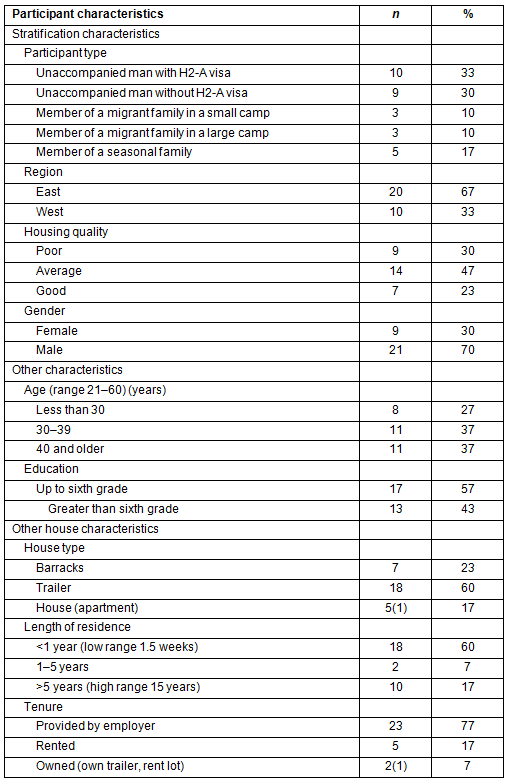
Themes
Several themes emerged that reflect widespread and persistent housing concerns with implications for health and safety. These included exposure to pesticides, safety issues, pests, water supply and air quality, temperature and moisture.
Exposure to pesticides: Due to the close proximity of the agricultural fields to the participants' housing, concerns regarding pesticides were intrinsically linked to the housing narrative (Fig1). Several participants described the smell that would follow fields being sprayed with chemicals. One man stated:
Since those chemicals are strong, we always came inside. Sometimes, they give you a headache or make you feel like you're going to vomit when they spray that type of chemical. When we're picking in the afternoon, we vomit, get a headache, or feel bad because those chemicals they put on it are strong. That's when we're picking tobacco. (ID 26)
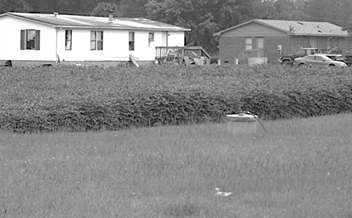 Figure 1: Proximity of workers' housing to fields.
Figure 1: Proximity of workers' housing to fields.
A woman (ID 01) expressed similar sentiments and that after the fields were sprayed, her young children would have to play inside the house for several days. She noted that she was still able to smell the pesticides even when inside.
A more persistent concern among the farmworkers was the direct exposure while working in the fields to pesticides and other chemicals that remained on their clothing and shoes, thus risking contamination of their homes when returning at the end of the work day. When asked about health concerns, the same woman gave the following answer:
I don't know how to explain - sometimes a person is exposed to things without knowing it. I don't know - chemicals or something. Because my husband works here in the sweet potato packing plant and the sweet potatoes carry what is put on them - some chemicals, and then a person holds them. They are here also because his clothes are dirty with everything they use there. (ID 01)
Several of the participants described how they were able to separate out their work clothes from other normal-wear clothes and their families' clothes. In order to accomplish this, they had separate laundry bins and kept shoes outside. Two barriers to adequate separation of work clothes were limited laundry facilities and limited space to store clothing. Several participants expressed that if the conditions of the water were better, they would be more inclined to do laundry in their homes or camps. Several remarked that the water was so dirty they had no choice but to leave and find a laundromat in town. Others described how one washer and dryer was available for the entire camp, so it just was not feasible for them to do their laundry at the camp.
Possessing adequate storage for separation of potentially contaminated work clothes was a persistent issue of concern expressed by many of the farmworkers. One man stated that he stored his work clothes 'in a basket which I shouldn't keep in my bedroom, but I do anyway' (ID 22). A participant described how helpful it would be to have a chest of drawers for storage space of dirty clothes (Fig2). He noted:
When we take our work clothes off now, we leave them lying in the corners of the room ... [E]verything we touch sticks to our clothes. But, thank God, we haven't gotten sick because of it. (ID 07)
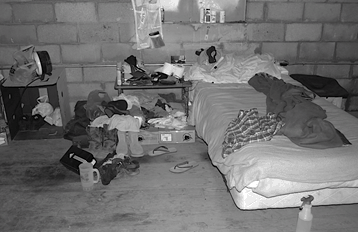 Figure 2: Storage of potentially contaminated work clothes.
Figure 2: Storage of potentially contaminated work clothes.
The overall health perceptions related to pesticide exposure and housing was that if workers were not experiencing short-term illnesses or symptoms from it, pesticide exposure was not a long-term concern for the participants.
Safety issues: Participants expressed many housing safety concerns and noted in the photographs. Often the concern was related to faulty utilities and electricity. One mother described how she felt very uneasy about the state of the electrical situation around her toddler-age children:
The problem is with the electrical outlets because they are very old, and the electrical appliances are new. So then, there are problems with connecting them. So I have to invent ways for them to work. I use extension cords. But the wood around the outlets is also worn out and the outlets are just hanging there. So then, it's dangerous for the small children because they could put their fingers in them. (ID 03)
Another man described how the lights were always out, and electricity supply was regularly lost. He said that he had fallen many times in the dark, as he used his cell phone to light a path to walk. Another man described how the frequent loss of electricity caused concerns in the kitchen regarding food preparation. When the electricity was off, he and the other men routinely ate canned foods cold. He suggested that eating canned foods cold gave him an upset stomach:
It could be from the canned food. It doesn't set well on your stomach because it's cold. Who knows? It might be because we've never had to eat like that - just canned stuff. We've always cooked hot food [in the past]. (ID 06)
Another frequently discussed topic of concern among participants regarding safety was the lack of working locks on doors and windows (Fig3). One woman describes her perceptions:
Those [the locks] are bad because the doors are not secure. I try to lock them, but they won't lock because they are very worn. Sometimes when I'm by myself, I put a chair behind them so they won't open. Most of all, I try to keep the telephone at hand for whatever emergency. Sometimes, I'm a little scared. I don't think my neighbors would try to come in, but someone outside might. They are out looking for money or trying to steal a television. There are people who do that because they want drugs or alcohol. (ID 02)
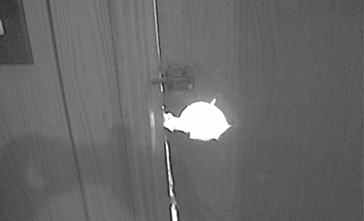 Figure 3: Security (broken locks and door knob).
Figure 3: Security (broken locks and door knob).
Even with numerous descriptions and photographs of faulty locks and broken windows, many of the participants expressed how safe they felt within the camp or their trailer community and felt comfortable with their neighbors. When asked directly about perceived safety in the trailer community, one man stated, 'we don't have problems about feeling insecure' (ID 22), and these sentiments were commonly expressed.
Pests: Many of the problems described relating to pests (primarily cockroaches, mice and rats) were a result of limited structural integrity (ie holes in the wall). Several participants described rotting floors, roofs and ceilings that were both structurally unsafe and would allow pests into the home (Fig4). One man stated, 'Mice and cockroaches come in [the holes in the house]' (ID 11). Lack of storage space in the kitchen was another pressing concern.
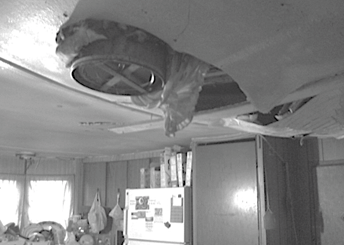 Figure 4: Structural integrity.
Figure 4: Structural integrity.
Another man described housing conditions that he recently experienced while working in Florida:
The floors are wood that you almost fall through if you walk on them. If you go to bed at 10.00 or 11.00 and you get up and turn the lights on, you see cockroaches all over the place, on the table, on the bed, everywhere. I'm not sure why they allow them to rent those trailers in Florida because they are in terrible condition. Everything, like the windows and the doors are broken. Flies are here and there because they come in wherever they want to. There are rats. Well, they have everything. Even the beds are all dirty, but you go to sleep on them because you put a sheet over them and they look clean. But the mattresses are extremely bad, honestly, the worst. There are trailers for rent because they permit them to rent them in those conditions. (ID 22)
Some participants attributed pest problems to the 'filth of dirty dishes and trash' in the house (ID 20). Another man stated, 'the boss-man routinely puts the poison out for the rats' (ID 12), indicating a long-standing problem with pest and rodent control. Housing conditions that included infestations of cockroaches, mice and rats were persistent within the descriptions.
Water supply: Another common concern was the water supply for the house. One man stated that he just had to get used to the bad taste of the water. He would fill his cooler with this water and drink it, even when his stomach would begin to hurt. For this reason, he limited the amount of water he drank during the day.
Another man described his water supply in the following passage:
[T]he bathroom didn't work, and we had to flush the toilet with a bucket. I got fed up with asking my patron for a new toilet because it would get black in 15 days after my wife cleaned it with bleach. I wanted that done because of my children, but I think it kept getting dirty because the water was dirty. The water was so dirty that we had to shower by hand because the showerhead was clogged. The water that came out looked orange. It had like dirt it in. (ID 30)
Another woman described:
The water here isn't drinkable because it's dirty. It smells bad. A while ago, in front of my home there lived a lady who went and complained to the trailer park owner about the water being dirty and having trash in it - that it had a lot of dirt in it. If you used a colander, it would fill up with trash. [ID 02]
Water insecurity and issues related to water quality were highly distressing to the participants.
Air quality, temperature and moisture: Nearly all of the participants described matters regarding air quality, problems with temperature of the house, and issues related to moisture and mold development (Fig5). Some issues were related to stoves in the home, and the majority of the examples were related to stoves used for heating.
 Figure 5: Moisture in the kitchen.
Figure 5: Moisture in the kitchen.
Another man described crowded living conditions that he previously experienced in Michigan (ID 09). He described sleeping on the mattress on the floor and remaining awake at night because the heating unit they used would emit smoke and fumes. A participant also recounted a time when he lived in close proximity to barns that were used for burning, and he expressed that he would only sleep a couple hours a night due to the smoke inhalation that kept him awake (ID 17).
The air inside the home was described as stagnant and 'heavy'. Adequate heating and cooling systems were not always guaranteed. One man described:
The roof fell in and since then, it's been leaking and that is a problem for us. Yes, it gets wet. For that reason, we put a bucket underneath the leak to collect the water that's falling. Also the house doesn't have air conditioning - only the ones in the windows. So, when it's hot, we suffer from the heat. When it's cold, we suffer from the cold. We only have that heater over there [a space heater]. (ID 13).
This man further described his rationale for leaving his young family at home in Mexico in the following statement:
If we had our children here, do you think a small child is going to be able to stand the heat in the summer without air, or the cold? Do you think a small child could stand it? In the winter, we cover ourselves with five or six blankets. Do you think a baby or a small child could stand such a heavy load on top of him? He could die. (ID 13).
Dampness and humidity were persistent problems described by the participants and found in the photographs. One young mother describes her daughter's development of asthma:
When I arrived here, the carpet in my bedroom was super dirty, the dirtiest that you could possibly imagine and then, my little girl got sick. I took her to the clinic and they told me that she had asthma symptoms and I think it was because of the humidity in the house. I had to change the carpet for other flooring. The landlord didn't want to do it so I had to. (ID 10)
Another woman illustrated the following:
It got wet and the walls, which look like cardboard, were falling down in pieces and when you took a bath, the water would get into the bedroom and that caused a mold problem. So then, the situation was very difficult. (ID 03)
Many farmworkers described how they 'put up with it' (the housing conditions) because, quite simply, they want to remain in the USA to work.
Discussion
Many of the study participants described poor housing conditions that were reflected in the photographic analysis of the houses and camps. This qualitative approach allows for a rich understanding of farmworkers' perceptions of housing quality and potential impacts on health.
Few studies have assessed the conditions of migrant farmworker housing, and all of them have found conditions to be variable but overwhelmingly poor on both the East and West Coasts of the USA7,11,12,26-32. When Quandt et al11 specifically assessed cooking and eating facilities of migrant farmworker housing, they concluded at least 10 percent of camps had eight or more of 15 kitchen-specific violations, including improper refrigerator temperature (65.5%), cockroach infestation (45.9%), contaminated water (34.4%), rodent infestation (28.9%), improper flooring (25.8%), unsanitary conditions (21.1%), improper fire extinguisher (19.9%), and holes or leaks in the wall (12.1%). Bischoff et al18 ascertained that 34 percent of North Carolina farmworker camps failed the total coliform rule in their drinking water supply, indicating a potentially harmful bacterial presence. Two of the camps assessed tested positive for Escherichia coli in the water supply, which has the potential to cause severe illness18. A study by Gentry et al30 found most migrant farmworker households in North Carolina were crowded, often located adjacent to the fields, suffered from structural problems, and lacked necessary facilities and appliances.
Pesticide exposure through clothing contamination, inadequate storage, inadequate laundry facilities and proximity to the fields were a common element of the farmworkers' shared housing narrative; and this supports previous findings from this cohort, which found multiple housing violations in the North Carolina migrant farmworker camps7. Of note, many of the symptoms that were described were general symptoms of malaise and could also be attributed to green tobacco sickness or heat stress19,33. Several participants described how they were able to keep their laundry separate from other housemates' clothing, but this was often not the case. Unfortunately, previous researchers have demonstrated numerous negative health sequelae as a result of this occupational and household pesticide exposure31,34-38. Communication of pesticide exposure risks to members of the community and implementation of standardized actions of response are still areas of research in need of attention39.
Residential dampness, mold, and examples of poor air quality as a result of stoves, heating devices or allergens (eg cockroach exposure) were also housing conditions commonly described by the participants. Numerous photographs indicated water damage within the house. Dampness, poor air quality, and mold and allergens are risk factors for poor respiratory health. In particular, this risk can lead to the development of asthma, or to the onset of frequent asthma attacks, which has the potential to cause significant morbidity40-45. These types of conditions also place the farmworkers at an increased risk of fungal infections46.
In addition to health issues related to dampness and mold, there is evidence suggesting most rooms in North Carolina farmworker camps exhibit dangerous heat indices19. Severe heat indices can cause acute problems such as heat stroke and respiratory distress, and exacerbate chronic conditions such as asthma and allergies. Quandt et al suggest that exposure to high ambient temperature and humidity during sleep at night can prolong recovery from heat stress experienced while working during the day19.
The majority of participants reported that they felt safe within their community or neighborhood. While many participants lived with housemates to whom they were not related, they did not report many problems resulting from living with unrelated individuals, beyond minor annoyances. Despite accounts of perceived safety, there were numerous examples within the findings where the housing structure itself was not secure from potential intruders, due to faulty doors, locks or windows. This finding substantiates previous research that stated approximately 84 percent of migrant farmworkers felt as though they or their possessions were not secure in their home environment47. Even though the perception of safety exists among many of the farmworkers in this study, the threat of harm persists. In 2012, a migrant farmworker community in eastern North Carolina was targeted with multiple burglary attempts, which ended in the shooting of a four-year-old boy48.
Descriptions of water conditions, with visible dirt and discoloration, and self-report of gastrointestinal symptoms after water consumption, are concerning findings. Previous reports have demonstrated unhealthy levels of coliform bacteria growth and even the presence of Escherichia coli found in the water supply of North Carolina farmworker camps18. Previous research has also demonstrated violations in farmworker kitchens, which could dramatically impact on food contamination and preparation. The qualitative findings contribute to previous quantitative data conducted within this study cohort, which observed violations of eight kitchen regulations in at least 10 percent of the camps (violations such as improper refrigerator temperature, cockroach infestation, contaminated water, rodent infestation, improper flooring, unsanitary conditions, improper fire extinguisher and holes or leaks in the wall)11.
Additional research is needed to understand the confluence of housing conditions of migrant farmworkers and their families and social policies. The Migrant and Seasonal Agricultural Worker Protection Act (MSPA) was enacted more than a quarter of a century ago to improve the conditions of employment for farmworkers49. Even so, the enforcement of housing standards for employee-provided migrant housing under the auspices of the MSPA remains unpredictable due to various enforcement agencies having jurisdiction within states49. Unfortunately, discrimination against migrant farmworkers has been a persistent trend within the past half century, and these policies and actions have allowed sub-standard housing conditions to persist within communities50. Additional study is needed to understand regional differences in access to adequate housing for migrant farmworkers because of the variations in oversight and provision of employer-based housing14. This study suggests there is much room for sustained advocacy and action, given that many of the farmworkers' descriptions and photographs depicted housing conditions that are below accepted standards of living. Access to adequate and safe employer-provided housing for migrant farmworkers should be considered a basic human right.
This study contributes to the literature by incorporating migrant farmworkers' perceptions of their housing conditions. There is a paucity of data regarding long-term health experiences of migrant families and impacts on children who live in the house. This study also incorporates views of several wives of farmworkers and of female farmworkers themselves. Their perspectives of housing conditions are a unique addition, enriching previous quantitative research demonstrating high levels of pesticide exposure among women and children who share living space with farmworkers32,34,51,52. While this study specifically focuses on housing conditions of migrant farmworkers, the findings have implications for future research directions for many underserved, low-income, non-English speaking, rural residents who may encounter various occupational and environmental exposures, often associated with low-paying jobs.
While this study has numerous strengths, the limitations must also be addressed. Due to the qualitative nature of this study, results are not generalizable beyond this rural region. Additionally, this study sampled from one state, so results may not be applicable to other states because of varying cultural norms and housing condition enforcement. Qualitative interviews and photographic observation were conducted cross-sectionally, therefore limiting the interpretation of the lived experience to one point in time. Also, perception and experiences may change depending on when the participant was interviewed in the season. Finally, participants who volunteered to participate in this study may differ from those who did not volunteer.
This study has numerous research, policy, and public health implications. Preliminary research has linked certain exposures to substantial long-term health impacts, but the mediating factors associated with poor housing quality have not been prospectively studied. Larger, prospective studies are needed to help further understand the myriad of risks migrant farmworkers and their families face when they live in poor housing conditions. Regulations for housing provided by employees are not uniformly enforced, leading to wide variations in farmworker housing quality. To mitigate sub-standard housing conditions that are violations of the MSPA, stronger enforcement of these regulations is needed to protect the health and wellbeing of migrant farmworkers7.
Acknowledgement
This study was supported by the National Institute of Environmental Health Sciences grant R01 ES012358.
References
1. Kandel W. Profile of hired farmworkers. A 2008 update profile of hired farmworkers (Online) 2008. Available: http://digitalcommons.ilr.cornell.edu/cgi/viewcontent.cgi?article=1564&context=key_workplace (Accessed 15 March 2013).
2. United Nations. International Migration Report 2009: A global assessment New York, New York (Online) 2011. Available: http://www.un.org/esa/population/publications/migration/WorldMigrationReport2009.pdf (Accessed 15 March 2013).
3. Arcury TA, Quandt SA. Delivery of health services to migrant and seasonal farmworkers. Annual Review of Public Health 28: 345-363 (Online) January 2007. Available: http://www.ncbi.nlm.nih.gov/pubmed/17291182 (Accessed 2 March 2013).
4. Holmes SM. An ethnographic study of the social context of migrant health in the United States. PLoS Medicine 3(10): e448 (Online) October 2006. Available: http://www.ncbi.nlm.nih.gov/pubmed/17076567 (Accessed 2 March 2013).
5. US Department of Labor. The National Agricultural Workers Survey (Online) 2004. Available: http://www.doleta.gov/agworker/report/ch1.cfm (Accessed 15 March 2013).
6. National Center for Farmworker Health. Farmworker Health Fact Sheet (Online) 2012. Available: http://www.ncfh.org/docs/fs-Facts about Farmworkers.pdf (Accessed 15 March 2013).
7. Arcury TA, Weir M, Chen H, Summers P, Pelletier LE, Galvan L, et al. Migrant farmworker housing regulation violations in North Carolina. American Journal of Industrial Medicine 2012; 55: 191-204.
8. Farquhar SA, Goff NM, Shadbeth N, Samples J, Ventura S, Sanchez V, et al. Occupational health and safety status of indigenous and Latino farmworkers in Oregon. Journal of Agricultural Safety and Health 2009; 15: 89-102.
9. Carroll DJ, Samardick R, Gabbard SB, Hernandez T. Findings from the National Agricultural Workers Survey: A demographic and employment profile of United States farm workers (Online) 2005. Available: http://wdr.doleta.gov/research/FullText_Documents/ETAOP_2013_04.pdf (Accessed 15 March 2013).
10. Vallejos QM, Quandt SA, Grzywacz JG, Isom S, Chen H, Galvan L, et al. Migrant farmworkers' housing conditions across an agricultural season in North Carolina. American Journal of Industrial Medicine 2011; 54: 533-544.
11. Quandt SA, Summers P, Bischoff WE, Chen H, Wiggins MF, Spears CR, et al. Cooking and eating facilities in migrant farmworker housing in North Carolina. American Journal of Public Health 103(3): e78-84 (Online) March 2013. Available: http://www.ncbi.nlm.nih.gov/pmc/articles/PMC3673492 (Accessed 5 May 2013).
12. Harrison P. Safe, clean, and affordable: California farmworker housing needs. Journal of Architectural and Planning Research 1995; 12: 19-34.
13. Arcury TA, Marin AJ. Latino/Hispanic farmworkers and farm work in the eastern United States: the context for health safety, and justice. In: TA Arcury, SA Quandt (Eds). Latino farmworkers in the eastern United States: health, safety and justice. New York: Springer; 2009; 15-36.
14. Villarejo D. California's hired farm workers move to the cities: the outsourcing of responsibility for farm labor housing. In: California Rural Legal Assistance Priorities Conference. Asilomar, California (Online) 2014; p. 1-34. Available: http://www.crla.org/sites/all/files/u6/2014/rju0214/VillarejoFrmLbrHsngHlth_CRLA_012414.pdf (Accessed 31 July 2014).
15. NC Department of Labor. Introduction to migrant housing inspections in North Carolina (Online) 2008. Available: http://www.nclabor.com/ash/ash_blue_book.pdf (Accessed 15 March 2013).
16. Holmes SM. The clinical gaze in the practice of migrant health: Mexican migrants in the United States. Social Science and Medicine 74(6): 873-881 (Online) March 2012. Available: http://www.ncbi.nlm.nih.gov/pubmed/21992736 (Accessed 3 March 2013).
17. Holmes SM. Structural vulnerability and hierarchies of ethnicity and citizenship on the farm. Medical Anthropology 2011; 30(4): 425-449.
18. Bischoff WE, Weir M, Summers P, Chen H, Quandt SA, Liebman AK, et al. The quality of drinking water in North Carolina farmworker camps. American Journal of Public Health 102(10): e49-54 (Online) October 2012. Available: http://www.ncbi.nlm.nih.gov/pubmed/22897558 (Accessed 5 May 2013).
19. Quandt SA, Wiggins MF, Chen H, Bischoff WE, Arcury TA. Heat index in migrant farmworker housing: Implications for rest and recovery from work-related heat stress. American Journal of Public Health 103(8): e24-e26 (Online) August 2013. Available: http://www.ncbi.nlm.nih.gov/pubmed/23763392 (Accessed 22 July 2013).
20. Gustafson CJ, Feldman SR, Quandt SA, Isom S, Chen H, Spears CR, et al. The association of skin conditions with housing conditions among North Carolina Latino migrant farm workers. International Journal of Dermatology 1-7 (Online) 15 May 2013. Available: http://www.ncbi.nlm.nih.gov/pubmed/23675774 (Accessed 20 May 2013).
21. Sandberg JC, Talton JW, Quandt SA, Chen H, Weir M, Doumani WR, et al. Association between housing quality and individual health characteristics on sleep quality among Latino farmworkers. Journal of Immigrant and Minority Health (Online) 18 November 2012. Available: http://www.ncbi.nlm.nih.gov/pubmed/23161266 (Accessed 22 July 2013).
22. Hsieh H-F, Shannon SE. Three approaches to qualitative content analysis. Qualitative Health Research 15(9): 1277-1288 (Online) 1 November 2005. Available: http://qhr.sagepub.com/content/15/9/1277 (Accessed 2 March 2012).
23. Cohen MZ, Kahn DL, Steeves RH. Hermeneutic phenomenological research. Thousand Oaks, CA: Sage, 2000.
24. Schwartz D. Visual ethnography: using photography in qualitative research. Qualitative Sociology 1989; 12(2): 119-154.
25. Lincoln Y, Guba E. Naturalistic inquiry. Beverly Hills, CA: Sage Publications; 1985.
26. Ziebarth A. Housing seasonal workers for the Minnesota processed vegetable industry. Rural Sociology 2006; 1(2): 335-357.
27. Holden C, George L, Smith A. No refuge from the fields: findings from a survey of farmworker housing conditions in the United States Washington, DC (Online) 2001. Available: http://www.ruralhome.org/storage/documents/norefuge.pdf (Accessed 15 March 2013).
28. Early J, Davis SW, Quandt SA, Rao P, Snively BM, Arcury TA. Housing characteristics of farmworker families in North Carolina. Journal of Immigrant and Minority Health 8(2): 173-184 (Online) April 2006. Available: http://www.ncbi.nlm.nih.gov/pubmed/16649132 (Accessed 14 May 2013).
29. Flocks JD, Burns AF. Stakeholder analysis of Florida farmworker housing. Journal of Agromedicine 2006; 11(1): 59-67.
30. Gentry A, Grzywacz J, Quandt SA, Davis S, Arcury TA. Housing quality among North Carolina farmworker families. Journal of Agricultural Safety and Health 13(3): 323-337 (Online) July 2007. Available: http://www.ncbi.nlm.nih.gov/pubmed/17892074 (Accessed 15 March 2013).
31. Quirós-Alcalá L, Bradman A, Nishioka M, Harnly ME, Hubbard A, McKone TE, et al. Pesticides in house dust from urban and farmworker households in California: an observational measurement study. Environmental Health 10(1): 19 (Online) January 2011. Available: http://www.ncbi.nlm.nih.gov/pubmed/21410986 (Accessd 14 May 2013).
32. Bradman A, Salvatore AL, Boeniger M, Castorina R, Snyder J, Barr DB, et al. Community-based intervention to reduce pesticide exposure to farmworkers and potential take-home exposure to their families. Journal of Exposure Science and Environmental Epidemiology 19(1): 79-89 (Online) January 2009. Available: http://www.ncbi.nlm.nih.gov/pubmed/18368011 (Accessed 23 July 2013).
33. Arcury TA, Vallejos QM, Schulz MR, Feldman SR, Fleischer, AB, Verma A, et al. Green tobacco sickness and skin integrity among migrant Latino farmworkers. American Journal of Industrial Medicine 2008; 51: 195-203.
34. Bradman A, Whitaker D, Quirós L, Castorina R, Claus Henn B, Nishioka M, et al. Pesticides and their metabolites in the homes and urine of farmworker children living in the Salinas Valley, CA. Journal of Exposure Science and Environmental Epidemiology 17(4): 331-349 (Online) July 2007. Available: http://www.ncbi.nlm.nih.gov/pubmed/16736054 (Accessed 11 April 2013).
35. Morgan MK. Children's exposures to pyrethroid insecticides at home: a review of data collected in published exposure measurement studies conducted in the United States. International Journal of Environmental Research Public Health 9(8): 2964-2985 (Online) August 2012. Available: http://www.ncbi.nlm.nih.gov/pubmed/23066409 (Accessed 27 March 2013).
36. Snipes SA, Thompson B, O'Connor K, Shell-Duncan B, King D, Herrera AP, et al. 'Pesticides protect the fruit, but not the people': using community-based ethnography to understand farmworker pesticide-exposure risks. American Journal of Public Health 99(Suppl 3): S616-621 (Online) November 2009. Available: http://www.ncbi.nlm.nih.gov/pmc/articles/PMC2774205 (Accessed 14 May 2013).
37. Quandt SA, Hernandez-Valero MA, Grzywacz JG, Hovey JD, Gonzales M, Arcury TA. Workplace, household, and personal predictors of pesticide exposure and health outcomes for farmworkers. Environmental Health Perspectives 2006; 114: 943-952.
38. Arcury TA, Grzywacz JG, Talton JW, Chen H, Vallejos QM, Galvan L, et al. Repeated pesticide exposure among North Carolina migrant and seasonal farmworkers. American Journal of Industrial Medicine 2010; 53: 802-813.
39. Quandt SA, Doran AM, Rao P, Hoppin JA, Snively BM, Arcury TA. Reporting pesticide assessment results to farmworker families: development, implementation, and evaluation of a risk communication strategy. Environmental Health Perspectives 112(5): 636-642 (Online) 6 January 2004. Available: http://www.ncbi.nlm.nih.gov/pmc/articles/PMC1241934 (Accessed 23 July 2013).
40. Fisk WJ, Eliseeva EA, Mendell MJ. Association of residential dampness and mold with respiratory tract infections and bronchitis: a meta-analysis. Environmental Health 9(1): 72 (Online) January 2010. Available: http://www.ehjournal.net/content/9/1/72 (Accessed 14 May 2013).
41. Heinrich J. Influence of indoor factors in dwellings on the development of childhood asthma. International Journal of Hygiene and Environmental Health 214(1): 1-25 (Online) January 2011 Available: http://www.ncbi.nlm.nih.gov/pubmed/20851050 (Accessed 11 March 2013).
42. Keall MD, Crane J, Baker MG, Wickens K, Howden-Chapman P, Cunningham M. A measure for quantifying the impact of housing quality on respiratory health: a cross-sectional study. Environmental Health 11(1): 33 (Online) January 2012. Available: http://www.ehjournal.net/content/11/1/33 (Accessed 25 March 2013).
43. Richardson G, Eick S, Jones R. How is the indoor environment related to asthma? Literature review. Journal of Advanced Nursing 52(3): 328-339 (Online) November 2005. Available: http://www.ncbi.nlm.nih.gov/pubmed/16194186 (Accessed 15 March 2013).
44. Sahakian NM, Park J-H, Cox-Ganser JM. Dampness and mold in the indoor environment: implications for asthma. Immunology and Allergy Clinics of North America 28(3): 485-505, vii (Online) August 2008. Available: http://www.ncbi.nlm.nih.gov/pubmed/18572103 (Accessed 14 May 2013).
45. Quansah R, Jaakkola MS, Hugg TT, Heikkinen SA, Jaakkola JJK. Residential dampness and molds and the risk of developing asthma: a systematic review and meta-analysis. PLoS One 7(11): e47526 (Online) January 2012. Available: http://journals.plos.org/plosone/article?id=10.1371/journal.pone.0047526 (Accessed 21 May 2013).
46. McKinsey DS, McKinsey JP. Pulmonary histoplasmosis. Seminars in Respiratory and Critical Care Medicine 32(6): 735-744 (Online) December 2011. Available: http://www.ncbi.nlm.nih.gov/pubmed/22167401 (Accessed 15 March 2013).
47. Arcury TA, Weir MM, Summers P, Chen H, Bailey M, Wiggins MF, et al. Safety, security, hygiene and privacy in migrant farmworker housing. New Solutions: A Journal of Environmental and Occupational Health Policy 22(2): 153-173 (Online) January 2012. Available: http://www.ncbi.nlm.nih.gov/pubmed/22776578 (Accessed 15 March 2013).
48. Holmes K. Sampson burglaries, shooting target migrant workers (Online) 2012. Available: http://www.wral.com/Sampson-burglaries-shooting-target-migrant-workers/11790498 (Accessed 7 October 2013).
49. HR 1886, MSPA Clarification Act, H.R. 2757, Housing Opportunities for Migrant Employees, H.R. 3121, Amending the Migrant and Seasonal Agricultural Worker Protection Act. US Government Printing Office; 1999.
50. Ramirez SM, Villarejo D. Poverty, housing, and the rural slum: policies and the production of inequities, past and present. American Journal of Public Health 102(9): 1664-1675 (Online) September 2012. Available: http://www.ncbi.nlm.nih.gov/pubmed/22813088 (Accessed 9 September 2013).
51. Eskenazi B, Bradman A, Castorina R. Exposures of children to organophosphate pesticides and their potential adverse health effects exposures of farmworkers and their Families. Environmental Health Perspectives 1999; 107: 409-419.
52. Curl CL, Fenske RA, Kissel JC, Shirai JH, Moate TF, Griffith W, et al. Evaluation of take-home organophosphorus pesticide exposure among agricultural workers and their children. Environmental Health Perspectives 110(12): A787-792 (Online) December 2002. Available: http://www.ncbi.nlm.nih.gov/pubmed/12460819 (Accessed 15 March 2013).



